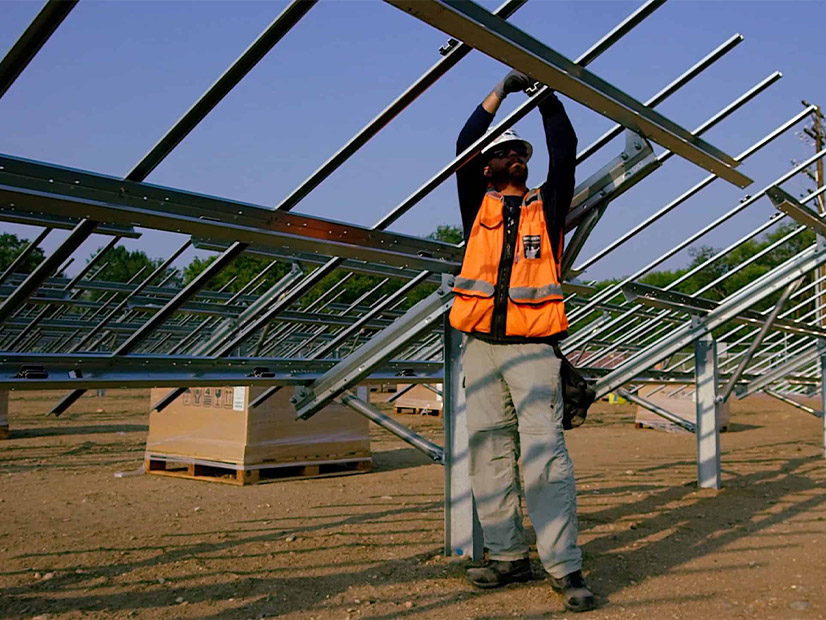MISO said new queue entries must wait while it takes another swing at imposing an annual megawatt cap on its interconnection queue.
MISO Manager of Generation Interconnection Ryan Westphal said the RTO will file by the end of the year for a cap to create a leaner and less backlogged waiting room for new generation. He said it won’t accept applications for new generation projects until it hears from FERC on the filing. That likely will leave MISO a year behind on its queue processing.
“Our plan right now would be to get this through before we open another queue,” Westphal told stakeholders during an Interconnection Process Working Group teleconference June 4.
Months ago, MISO staff hoped the RTO could begin processing both the 2023 and 2024 cycles of queue applications before the end of the year. That no longer appears to be the case. When asked by stakeholders, Westphal wouldn’t venture an estimate as to how long before MISO would begin study work on the 2024 cycle of interconnection requests.
MISO’s 2023 class of queue applications was delayed into early 2024 while it tried for new rules to discourage speculative projects from entering the queue. Those rules included its unsuccessful first attempt at a megawatt cap. (See MISO Reports 123-GW Roster for 2023 Interconnection Queue Cycle.) In April, MISO reported a 2023 queue intake of 123 GW spread across about 600 interconnection requests, substantially lower than 2022’s 171 GW of proposed generation projects across 956 interconnect requests.
FERC late last year denied MISO’s proposal to cap generation projects entering its interconnection queue on concerns over too many cap exemptions, the formula to establish the cap and potential resource adequacy deficits from limiting new generation onto the grid. However, FERC said a “cap in some form could be beneficial.” (See FERC Rejects MW Cap, Approves MISO’s Other Stricter Interconnection Queue Rules.)
MISO maintains that some limit on projects remains necessary. It said too many applications result in an overwhelming study process and make it nearly impossible to resolve models for a hypothetical system loaded with new generation.
“We did get a 30% reduction in the 2023 cycle versus 2022, but we still think we need to cap annual cycles. … We think this is necessary for the future to maintain an orderly queue going forward,” Westphal said. “Ultimately, we want to have a queue that’s fast and efficient where [we’re] giving you good information so you can make better decisions. That’s the hope, and we think that’s achievable with less volume.”
Westphal said that, had MISO this year encountered the volumes it experienced in 2022, the queue could be as high as 350 GW by now. He emphasized that MISO’s peak load expectation is 127 GW.
Westphal said MISO is leaning toward simplifying the calculation, which could be as “simple as a percentage of load.” He said MISO staff are at the same time contemplating ways to “limit the use of exemptions” to the cap to better the chances of it passing FERC’s judgment.
Finally, Westphal reassured stakeholders that MISO is thinking about its future resource adequacy needs alongside its second attempt at a cap design. He said MISO envisions that a cap would put it in position to administer less onerous studies more quickly and deliver more interconnection approvals sooner.
Curb ‘Queue Crashing,’ Savion Advises
However, Derek Sunderman, of Shell subsidiary Savion, said that instead of a hard megawatt cap, MISO should pursue a “gating mechanism” to deter disproportionate applications from a handful of interconnection customers.
He said some interconnection customers will “queue crash,” or submit large volumes of interconnection requests into a study application window to secure grid hookups.
Sunderman said MISO should consider administering a volumetric price escalation in the queue, where interconnection customers’ fees and penalties rise as they submit more projects for study. He said higher milestone fees for 4 GW worth of applications versus 1 GW of submittals would allow smaller interconnection customers to meaningfully participate in the queue while still allowing larger interconnection customers to submit as many projects as they believe feasible. He also said escalating prices would cause large corporations to rethink their projects’ viability.
Sunderman said if MISO pursues a hard cap at a hypothetical 80 GW, it might encourage a mad dash among developers to snap up queue positions. Volumetric price escalation, on the other hand, would allow all kinds of developers access, he said.
“It’s not a fight of the fittest of who can consume the most megawatts first,” Sunderman explained. “We’re concerned that the higher-equipped companies could control a percentage of the queue” under a hard cap.
Westphal said MISO would consider Savion’s proposal and hold more discussion on a cap design at the Interconnection Process Working Group’s meeting July 23.




